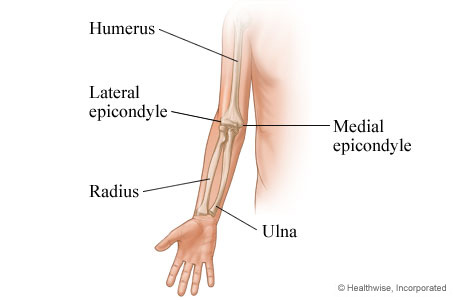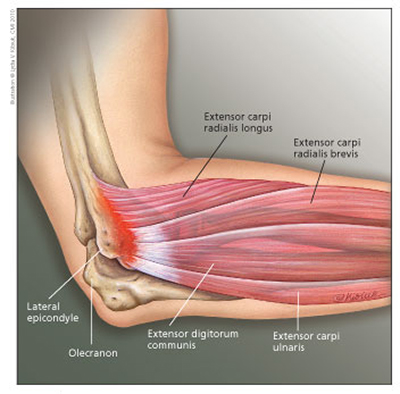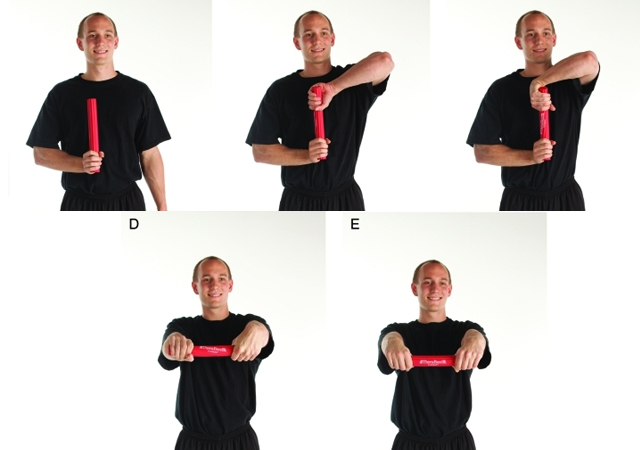
This
post was originally published on
this sitehttps://www.girlsgonestrong.com/
Hi Ann,
I’ve been dealing with pain in my elbow for about 2 months. I recently started to play tennis twice a week, and I notice that it hurts during my backhand. My elbow is tender right on the bone, and it hurts when I grip or carry anything. What do you think is going on and how can I start feeling better?

It sounds like you might be dealing with what is commonly called “Tennis Elbow.” The medical term for this is Lateral Epicondylitis, which is a fancy word that means you have inflammation and tenderness of the extensor muscles of the forearm. Let’s take a look at the anatomy, and then talk about what to do.

The elbow joint is made up of three bones: the humerus (upper arm bone), the radius, and the ulna. The bony bumps on the end of the humerus are called the epicondyles. The muscles that flex the wrist attach on the medial epicondyle, and the muscles that extend the wrist attach on the lateral epicondyle.

The muscle most commonly involved in lateral epicondylitis (Tennis Elbow) is the Extensor Carpi Radialis Brevis (ECRB). This muscle helps to stabilize the wrist when the elbow is extended.
Causes of Tennis Elbow can include repetitive motions from activities such as tennis, or job related activities requiring lifting and twisting, such as plumbing, auto work, and painting. With repetitive use, microscopic tears of the tendon can occur. These microtears cause a local inflammatory response to occur, and we get swelling and tenderness where the muscle attaches to the bone.
Lateral epicondylitis can also occur due to improper technique with activities such as tennis. In the early stages of this condition, we refer to tendinitis, but if the condition progresses and becomes more chronic, there is often no acute inflammation present. In the chronic stages, we refer to this as tendinopathy or tendinosis.
Symptoms include tenderness on the tendons or the epicondyle, pain with lifting, pain with shaking hands, and pain with gripping activities. Some people experience loss of grip strength as well. Symptoms are usually aggravated by activity such as sports or work activities that require some degree of wrist extension.

Early evaluation and treatment is always helpful in addressing Tennis Elbow. Symptoms may come on gradually, but if they begin to affect your daily activities, and aren’t responding to rest and ice, you may benefit from an evaluation by a Licensed Physical Therapist. You can go to a Physical Therapist without seeing your physician first in all 50 states.
Your Physical Therapist will talk with you about your symptoms, and examine your elbow. Through various tests and measures, we will determine which muscles are involved, and make sure that your symptoms aren’t being referred from an issue with your neck (sometimes neck issues can cause pain to radiate to the elbow). We will also assess your entire upper body, screening for weakness and movement issues in the upper back and shoulder.
Your Physical Therapist will work with you to develop a treatment plan based on findings, to allow you to reach your goals. Treatment may include stretching, strengthening exercises (research shows that loading tendons assists with the healing process), manual therapy including dry needling, activity modification, and evaluation of your technique and equipment for sports. We will also provide education about pain and provide resources for you. We may refer you to a physician if we think that you need diagnostic tests or medication, and we may also recommend an evaluation with a tennis pro if tennis is something you want to continue.
Some people with Tennis Elbow benefit from a counterforce brace, which is worn just below the elbow. This type of brace applies pressure to the tendons to allow the insertion of the tendon on the bone to rest. Conservative treatment is usually very effective; rarely, some people require surgery to remove damaged tissue and reattach healthy tissue to the bone.
Research has shown that eccentric exercise can be beneficial in the treatment of Tennis Elbow. Eccentric exercise involves a contraction of the involved muscles as they lengthen. This article describes the use of eccentric exercise in the treatment of this condition.

Remember that early consultation with your Physical Therapist can get you started on the road to recovery, and get you back to work—or the tennis court—quickly and safely.

 This
This 

 This
This 

 This
This 
 This
This 
 For now classes are 6pm and 640pm at 2840 Wildwood st in the Boise Cloggers studio.
Book your class NOW!
click this ==>
For now classes are 6pm and 640pm at 2840 Wildwood st in the Boise Cloggers studio.
Book your class NOW!
click this ==>








